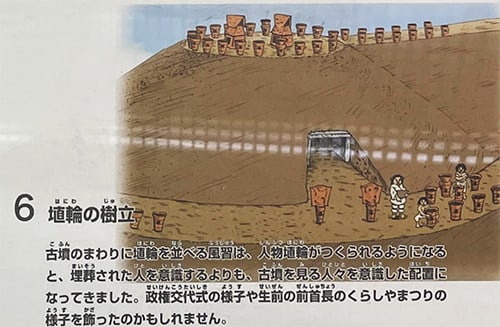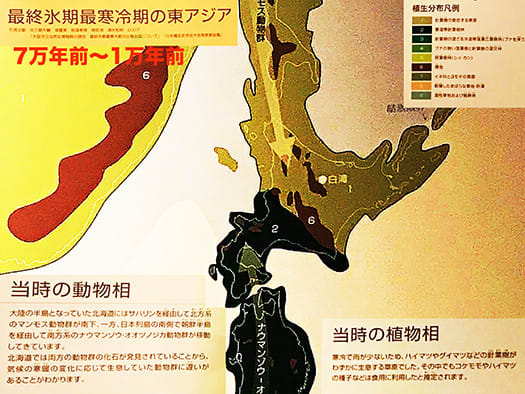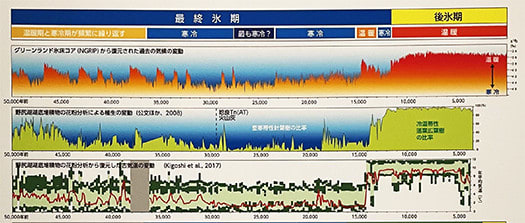
写真は国立歴史民俗博物館(千葉県)でのジオラマ展示から。石器時代の生活のワンシーンを象徴的に切り取っていて、たいへんわかりやすく好ましい。石器時代は動物という移動する資源に対して人間の側で「遊動」しながら、狩猟採集するというライフスタイル。
そういったライフスタイルでは石器に対しての社会全体の有用性追求が広く行われたでしょう。このワンシーンではたぶん「黒曜石」と思われる石器が一部欠けた様子をしげしげと観察している男子と、そのわが子の様子を見守っている父親の視線が表現されていた。
「え、どうしてこういうふうに欠け割れるんだろう」
「お、こいつ、石道具に興味を持ったのかな、そろそろ黒曜石採取に一緒に行くか・・・」
みたいな父子間での技術伝承のきっかけを描いているように感じられた。


石器時代を象徴する「道具」の最たるものは黒曜石とされる。黒曜石は別名天然ガラスといわれ、旧石器時代から縄文時代を通じ、弥生時代に鉄が伝わるまでさまざまな道具の主要な材料として使われた。
以下、「総論 黒曜石原産地遺跡研究の地平〜東京大学人文社会系研究科・文学部教授 佐藤 宏之/2016 (考古学ジャーナル2014年8月号掲載)」から要旨引用。図はきのうも紹介した北海道遠軽町白滝の「白滝ジオパーク」展示からです。
〜黒曜石は火山噴火に伴い噴出したマグマなどが急速に冷却された際に生成された火山ガラスであり、主要火山帯を中心に世界中に産地が広がるが、火山ごとにマグマの成分が異なるため、鉱物や化学成分組成の微妙な差異によって、正確な産地同定が可能。〜

〜大規模原産地は大型火山噴火口付近で産出するため山地帯に所在する。一方旧石器時代から縄文時代(38,000~11,700年前) の列島での人類活動は、台地や丘陵緩斜面の平坦地で展開されていたため、黒曜石の採取は計画的に行われねばならなかった。この時代は気候に対応して移動を繰り返す中大型動物の狩猟を主要な生業とした。そのため旧石器時代人は、主として平坦地において広域にわたる計画的な移動を伴う狩猟によって生活を維持しながらも、必要に応じて道具の素材として必須の黒曜石を山地帯に採取に赴くといった行動戦略を採用していた。〜
上の父子の様子とは、このタイミング事情を伝えてくれているように思えるのですね。東大・佐藤先生の文章からは当時の気候変動と植生分布、動物たちの行動原理などへの総合的な解析が伝わってきて、まことにわかりやすい。有用資源と人類のライフスタイルの歴史的相関の様子が、活性的に捉えられると思います。
地学と歴史の境界的領域、その密接な関係性をそこに見る思いです。
English version⬇
The transmission of technology and the search for useful resources in the Stone Age.
Dad, this stone broke when it was spun vertically. That's funny! Well, I guess we should go get the obsidian together. A scene of technology transmission between father and son in the Stone Age. A scene from the transmission of technology between father and son in the Stone Age.
The photo is from a diorama exhibit at the National Museum of Japanese History (Chiba Prefecture). It is a very clear and pleasing diorama that symbolically depicts a scene of life in the Stone Age. In the Stone Age, people lived a lifestyle of hunting and gathering while "playing" on the side of humans against mobile resources in the form of animals.
In such a lifestyle, the pursuit of usefulness of stone tools by society as a whole would have been widely pursued. In this scene, a boy is looking closely at a chipped piece of stone tool, probably obsidian, and his father is looking at his child.
The father looked at his son and said, "I wonder why it is chipped and broken like this.
"Oh, I wonder if he is interested in stone tools..." "Maybe it's time for me to go with him to collect obsidian..."
It seemed to me that the film depicted an opportunity for the father and son to pass on their skills to each other.
Obsidian is considered to be the most symbolic "tool" of the Stone Age. Obsidian, also known as natural glass, was used as the main material for various tools throughout the Paleolithic and Jomon periods, until iron was introduced in the Yayoi period.
The following is an abstract quotation from "General Introduction: Horizon of Research on the Obsidian Site of Origin - Hiroyuki Sato, Professor, Graduate School of Humanities and Sociology, Faculty of Letters, the University of Tokyo/2016 (published in the August 2014 issue of the Archaeological Journal)". The figure is from the "Shirataki Geopark" exhibit at Shirataki, Engaru Town, Hokkaido, which was introduced yesterday.
~Obsidian is a volcanic glass formed when magma ejected by volcanic eruptions cools rapidly, and its production areas are spread around the world, mainly in major volcanic belts. Since the composition of magma differs from one volcano to another, subtle differences in mineral and chemical compositions enable accurate identification of its production area. ~ (in Japanese)
〜The large source areas are located near large volcanic craters and are therefore located in mountainous regions. On the other hand, human activities in the archipelago from the Paleolithic to the Jomon period (38,000-11,700 years ago) were conducted on flat areas of plateaus and gentle slopes of hills, so the collection of obsidian had to be planned. In this period, hunting of medium to large-sized animals, which migrated repeatedly in response to the climate, was the main livelihood. Therefore, Paleolithic people maintained their livelihood by hunting, mainly on the plains, with systematic migration over large areas, while adopting a strategy of going to the mountains to collect obsidian, which was essential as a material for tools, when necessary. ~.
The above father and son situation seems to convey this timing situation, doesn't it? Dr. Sato's text conveys a comprehensive analysis of climate change, vegetation distribution, and the behavioral principles of the animals at that time, and is truly easy to understand. I believe that the historical correlation between useful resources and human lifestyles can be captured in an active manner.
I feel as if I could see the close relationship between geology and history in this borderline area.































